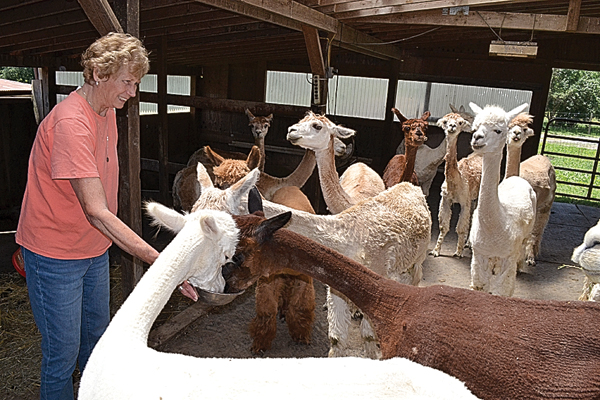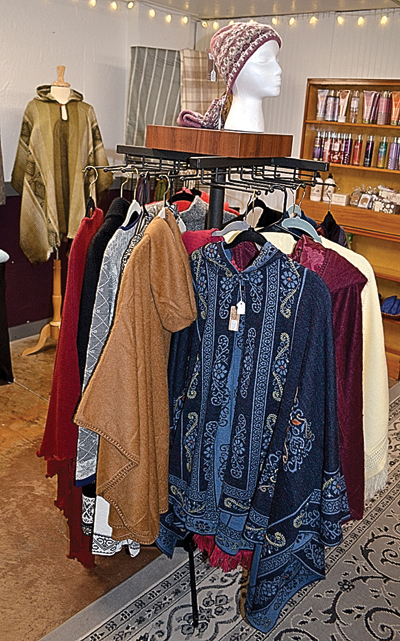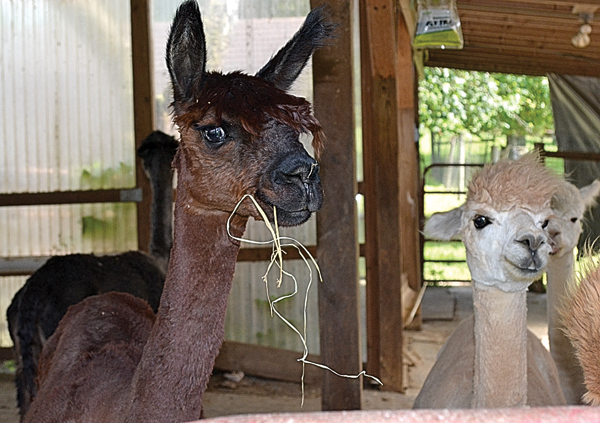
Becky Hammer holds a bowl of feed for the females in her herd of alpacas at Orchard Hill Farm in Elkins. Some of the girls fought for a turn at the bowl while others waited patiently for their turn.
Suzanne Stewart
Staff Writer
Just a few miles off of the Elkins 5-Lane – where the hustle and bustle of a large shopping center gives way to pastoral and peaceful scenes – you will find Orchard Hill Farm and 45 alpacas.
Owned and operated by Becky Hammer and her husband, Dan, the farm has been home to the curious creatures since 2002 when Becky decided to branch out from her career of showing horses.
“I’ve had horses, and I still have two, but I wanted something else that I could raise on the farm that didn’t take a lot of room, and alpacas don’t take a lot of room,” she said. “Also, I wanted something I didn’t have to eat because I do not eat the things on my farm.”
After seeing an ad in Country Living magazine about raising alpacas, Hammer began doing research and was soon on her way to California for an alpaca seminar.
“I ended up buying a girl that was pregnant, and then I bought one from Oregon that had just delivered,” she said. “So that’s where I started. They just multiplied from there. I’ve been all over the United States with alpacas, including West Virginia. One of the largest breeders of alpacas at the time was in Shinnston, outside of Clarksburg. He had four hundred alpacas.”
At one time, Hammer had 54 on her farm. Carrying on her love of showing animals, she started showing her alpacas all along the east coast.
“At the time, they were basically fifty percent confirmation, fifty percent on the fleece,” she explained. “With alpacas, they are raised for their fleece and that’s primarily what the shows were. Now, they’ve migrated to where the fleece is the main characteristic and not the confirmation.
“I was always a big proponent of confirmation,” she continued. “Confirmation is the bone structure and what they look like – their teeth and whether they’re straight and whether a breeding female can produce babies. Those are the things that you look for.”
Hammer has had a successful career in showing her alpacas and has come home with several master awards through the years.
The alpaca farming business is a large network that spans the country and Hammer soon became a member of the West Virginia Alpaca Organization, of which she is treasurer. She has also amassed quite a bit of knowledge about the South American natives.

A selection of fashionable ponchos, hats, socks, scarves and blankets made with Orchard Hill Farm alpaca fleece are available for purchase at the Tattered Rose Boutique in Marlinton.
Alpacas are members of the camelid family, which includes llamas, guanacos, vicuñas, alpacas and camels.
“There are two breeds of alpacas,” Hammer said. “There are Suris, which have a long drapey lock, which is a little bit different characteristic than the Huacayas. The Huacaya has the teddy bear look. Probably ninety-three percent of all the alpacas in the world are Huacayas.”
Alpacas come from three countries in South America – Peru, Bolivia and Chile. They are a herd animal and have been around for centuries. Their numbers dwindled drastically when the Spanish Conquistadors invaded the Andes Mountains. The herders continued to breed alpacas and their numbers rose again until the 1950s, when they were once again taken out – this time, by drug lords.
Thanks to importation, alpacas were sent around the world and farmers in the United States, Australia and Europe began to raise their own herds.
“The United States got into the alpaca business around ’84, and they started importing some to the United States,” Hammer said. “In fact, I had a full Chilean import. She was the gal I bought in Oregon.”
By 1998, the United States closed down the importation of alpacas, leading to the loss of their South American roots.
In addition to showing alpacas, Hammer got in the fiber business and has been sending her fleece away to be made into yarn and textiles which she sells online and at the Tattered Rose Boutique in Marlinton.
Alpaca fleece is very fine and soft, making it a coveted product for clothing and accessories. The fleece is graded one through six – with the very fine and softest of the fleece being used for finer materials while the coarser fleece is made into rug yarn.
“If you think anything about cashmere, a cashmere may have a micron count of twelve, which is very low,” Hammer explained. “A human hair is seventy. So if you touch your hair – it’s pretty soft. Think about twelve. The lowest one I ever had was a fifteen or fourteen. Now, as alpacas grow and get older, their fleece becomes coarser. Then it can’t be used for some of those very nice extravagant, luxurious sweaters or the silky type things that are so very nice.”
Although she is in the textile business with items made from fleece from her alpacas, Hammer is the first to admit, she is not crafty and does not use the yarn herself.
“I can’t make one thing,” she said. “I told the West Virginia Alpaca Organization I couldn’t weave; I couldn’t crochet. I couldn’t do any of those things. My thing was showing, breeding and now retail.”
The alpacas are sheared once a year at the farm, and the fleece “blankets” are sent away to be graded and made into products.
Alpacas have fleece in 22 different shades – from white to tan to dark brown to black – and the lighter colors are dyed to add to the variety of products.
Being on the 13-acre farm with Hammer and her alpacas, it is clear to see she has a passion for what she does, and the animals have a fondness for her.
In one field, the females relax near a pond until Hammer yells out, “Hey girls,” and they come running to the barn to get a treat.

Alpacas are inquisitive members of the camelid family. When they are content, they “hum” and can – at times – have bad table manners, as shown above.
They gather around and inquisitively sniff their owner and nibble at the feed.
In another field, the boys hang out and have a tendency to be a little rough with one another, each yearning to be the alpha of the herd. A third herd of the youngest alpacas is kept separate and near their own barn.
When Hammer and the occasional visitor walk among the alpacas, it’s hard to miss the contented “hum” they make which is a sign they are happy with their life on Orchard Hill.



